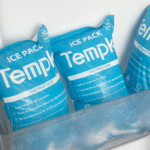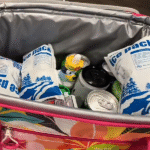Almohadillas de hielo secas: Cómo elegir, Tamaño & Envolver 2025
Si envías perecederos, dry ice pads can keep food safe or frozen when used correctly—and compliant labeling matters when real dry ice (Co₂ sólido) esta involucrado. Comience con reglas simples: plan 5–10 lb de hielo seco por 24 horas for deep-frozen lanes and keep chilled foods ≤40°F (4°C) de extremo a extremo. Para viajes de pasajeros, El hielo seco se limita a 2.5 kilos por paquete. Actualizado: Agosto 18, 2025.
-
Elige la derecha dry ice pads type for chilled vs. carriles congelados (cola larga: Almohadillas de hielo seco para el envío de alimentos.).
-
Calcular how many dry ice pads or pounds of dry ice you need for 24–72 hours (cola larga: ¿Cuántas almohadillas de hielo seco necesito?).
-
Pack and label UN1845 dry ice correctly in 2025 para evitar rechazos (cola larga: reglas de envío de hielo seco 2025).
-
Usar PCM pads and gel packs to skip hazmat when deep-freeze isn’t required.
What are dry ice pads—and which type do you need?
Respuesta corta: Dry ice pads can mean two things. Insulated dry ice pads are fabric covers used with real dry ice para ralentizar la sublimación. Reusable “dry-ice‑style pads” are polymer/PCM sheets you hydrate or freeze; they are no CO₂ and suit chilled or moderate frozen ranges. Use real dry ice for ultracold (−78.5 ° C) and use pads/PCM for 2–8°C or −10°C to −20°C targets.
Por que importa: Real dry ice requires vented packaging and UN1845 marcas; reusable pads/PCM don’t release gas and avoid hazmat paperwork, making handoffs simpler for many food lanes.
When should you choose PCM “dry ice pads” vs. Hielo seco realmente seco?
Para −20°C frozen but not ultracold: elegir PCM pads (p.ej., 5°F/−15°C setpoints) to stabilize loads without CO₂ handling. Para ultracold or hard-frozen (helado, long-haul meats), elegir Hielo seco realmente seco y desahogar el remitente. De cualquier manera, pre-chill products and fill voids to slow heat gain.
| Pad / Tipo de refrigerante | que es | Banda temporal típica | Lo que significa para ti |
|---|---|---|---|
| Insulated dry ice pad (cover) | Fabric/insulated topper used con hielo seco | Works with −78.5°C | Reduces sublimation during frequent access; not a coolant by itself. |
| Hydrated “dry-ice‑style” pad sheet | Polymer cells you wet/freeze | ~10–32°F (−12–0°C) | Great for 2–8°C chilled; fácil, non‑hazmat; ajuste flexible. |
| PCM panel (~5°F/−15°C) | Fixed‑setpoint phase‑change pack | ~5–20°F (−15–−6°C) | Bridges chilled–frozen gap; more stable than gel; no CO₂ gas. |
| hielo seco (Co₂, UN1845) | Solid carbon dioxide | −78.5 ° C (−109.3 ° F) | Best for ultracold; requiere ventilación + etiquetado; plan mass carefully. |
Consejos prácticos para ti
-
Acceso frecuente? Add an insulated dry ice pad over dry ice between picks to slow loss.
-
carriles refrigerados (≤40°F): Usar dry ice pads (sheets/gel) and pack tight; add a 5°F PCM if ambient is hot.
-
Congelado (−20°C) without hazmat: Usar PCM pads around the payload for a flat cold plateau.
Caso real: A cheesecake brand compared six “dry‑ice‑style” pads + two PCM panels vs. 12 lb dry ice in a 30‑qt shipper over 30 horas. Pads/PCM held 34–38°F with zero leaks; dry ice kept rock‑solid frozen—ideal for hard‑frozen SKUs.
How many dry ice pads—or pounds of dry ice—do you need?
Planning rules you can trust: Para enfriado carriles, empezar con ≈1 lb of pad/gel per cubic foot per 24 h; scale up 25–50% for hot routes or thin insulation. Para helado, plan 5–10 lb de hielo seco por 24 h per well‑insulated box. Validate with a small test and a logger before you scale.
estimador rápido (copiar/pegar):
| Tamaño del contenedor | Dry ice pads para 24 h (enfriado) | hielo seco para 24 h (congelado) | Lo que esto significa para ti |
|---|---|---|---|
| 25‑qt shipper | 2–3 hydrated pad sheets + 1 PCM panel | ~10–15 lb | Pads hit 33–40°F; use dry ice for hard‑frozen outcomes. |
| 45‑qt shipper | 4–5 pad sheets + 2 Paneles PCM | ~15–20 lb | Layer top & bottom for uniform temps. |
| 60‑qt shipper | 6 pad sheets + 2–3 PCM panels | ~18–25 lb | Fill voids and pre‑chill cargo to slow heat gain. |
Field‑tested sizing cues
-
Hot route or long transit? Agregar 25–50% coolant and consider PCM to smooth swings.
-
Punto de referencia: A 25‑qt cooler typically needs ~10–15 lb/day of dry ice for frozen results.
How to pack with dry ice pads (and with dry ice) for safe delivery?
Chilled with pads/PCM/gel (Sin peligro):
Pre -chill product ≤40°F; line bottom with pads; flank with PCM on the sides; top with gel; llenar los vacíos; completamente sello (no vent needed for pads/gel).
Frozen with dry ice (patria):
Freeze solid, lugar hielo seco en la parte superior (fregaderos fríos), vent package, y marca: "Hielo seco" o "dióxido de carbono, sólido," UN1845, peso neto de hielo seco (kilos), más Clase 9 etiqueta. Seguir el 2025 Lista de verificación de aceptación.
Etiquetado & 2025 compliance made simple (UN1845)
-
Desfogue: Never airtight—allow CO₂ to escape to avoid rupture.
-
Marcas: Nombre de envío adecuado, UN1845, Kg neto, cargador/consignatario, Clase 9 diamante.
-
viajes aéreos: 2.5 kilos dry ice per passenger package, Se requiere aprobación de la aerolínea.
-
Postal/Express: Aire USPS ≤5 lb; FedEx/UPS mirror IATA/49 CFR for packaging & marcas.
Texto de la etiqueta listos para copiar (ejemplo):
Pro tips that prevent warm arrivals
-
Condición previa: Freeze PCM/gel 24–36 horas; pre‑chill boxes.
-
Colocación: hielo seco arriba; almohadilla abajo + arriba; Minimizar el espacio de cabeza.
-
Validación: Drop a mini temperature logger in pilot boxes; standardize SOPs by lane.
Case in one line: With six pad sheets + two PCM panels, a 30‑hour lane held 34–38°F and avoided DG fees, while the same box with 12 libra de hielo seco arrived frozen solid. Choose per SKU and promise.
2025 trends in dry ice pads & cold chain—what changed?
Instantánea: El 2025 AQUI ESTA LA DGR (66ª ed.) and carrier checklists formalize UN1845 weight/marking clarity; Adopción de PCM grows as brands seek non‑DG stability for −20°C runs; Revestimiento VIP and better insulation reduce required coolant mass. Expect hybrid packs: PCM dry ice pads around the payload, con un smaller dry‑ice topper for margin.
Último progreso de un vistazo
-
Claridad de la lista de verificación: Fewer acceptance rejections when UN1845 and net kg are on the same panel.
-
−20°C PCM maturity: More vendors, better hold times, simpler reconditioning.
-
CO₂ supply dynamics: Mixed strategies hedge price/availability risk with PCM hybrids.
Insight del mercado: As insulation improves (p.ej., Revestimiento VIP), you’ll often ship the same payload with fewer pads or less dry ice, trimming freight and DG fees without sacrificing temperature.
Preguntas frecuentes
1) Are dry ice pads the same as dry ice?
No. Insulated pads cover real dry ice to slow loss; reusable “dry‑ice‑style” pads are gel/pcm and suit chilled/moderate frozen—no ultracold −78.5°C.
2) ¿Cuánto hielo seco por día debo planificar??
Comenzar con 5–10 lb por 24 h in a quality shipper; add 20–30% for summer lanes; verify with a test.
3) Do PCM “dry ice pads” need hazmat labels?
No. PCM pads don’t release CO₂ gas and don’t require Class 9 labels—still validate duration.
4) ¿Puedo volar con hielo seco??
Si, arriba a 2.5 kilos per passenger package in a ventilado container with airline approval and proper marks.
5) What food safety target should I follow for chilled shipments?
Keep foods ≤40°F (4°C) from packout through delivery; log pilot runs to confirm.
Resumen & Siguientes pasos
Puntos clave: Usar dry ice pads (pads/gel/PCM) for chilled or −20°C lanes; elegir hielo seco for ultracold, y respiradero + etiqueta UN1845 correctamente. Plan 1 lb/ft³/24 h for pads/gel and 5–10 lb/24 h para hielo seco, luego validar con un registrador. Mantener la comida ≤40°F across the journey.
Plan de acción:
-
Set your temperature goal (enfriado vs.. congelado).
-
Elige el refrigerante: pads/PCM for chilled/−20°C; hielo seco para ultrafrío.
-
Use the estimator above; add a summer buffer.
-
Imprimir etiquetas (si usa hielo seco) y sigue el 2025 lista de verificación.
-
Run a lane pilot, review data, then codify your SOP.
60‑Second Coolant Picker (lista de verificación interactiva)
-
Necesito ultrafrío (≤−70°C) → hielo seco + insulated pad cover; Etiqueta UN1845; ventilado.
-
Necesito congelado (−20°C) → PCM “dry ice pads” around payload; avoid DG paperwork.
-
Necesito enfriado (2–8 ° C) → Hydrated pad sheets/gel; full coverage; espacio de cabeza mínimo.
Acerca de Tempk
We design cold‑chain systems that meet your exact temperature and duration at the lowest total landed cost. Our engineers benchmark dry ice pads, gel, PCM, y aislamiento against your lanes, then deliver clear SOPs, safety notes, and label templates—validated with data loggers.
CTA: Want a free one‑lane packout template or sizing check? Habla con un especialista en Tempk hoy.
























